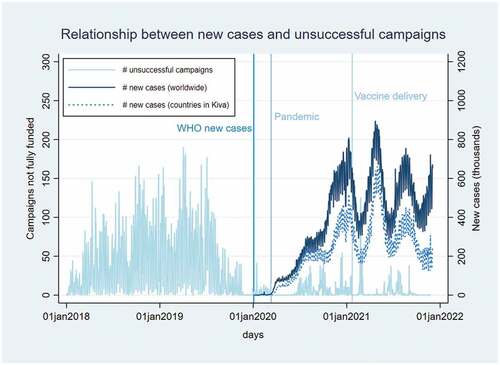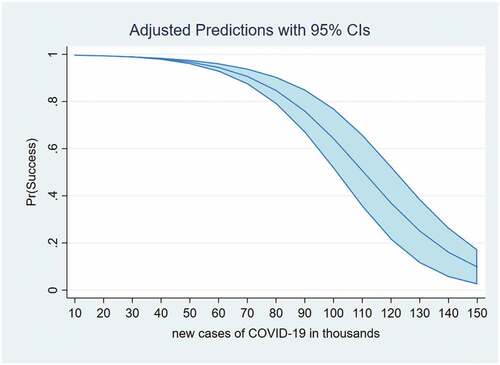ABSTRACT
The COVID-19 impact on global poverty dragged another 97 million people into poverty in 2020. Nonetheless, there is scant evidence reporting on the impacts on alternative means of financing designed to enable the poor during this global health crisis. This paper addresses this gap of funding impoverished entrepreneurs by studying the changes in their successfully funded campaigns on the largest crowdfunding microfinance platform prior and during COVID-19. After collecting data from January 2018 to November 2021 for a total of 767,112 campaigns, we report that the COVID-19 pandemic positively impacts on the funding success of the crowdfunding campaigns. However, rises in the daily number of COVID-19 cases negatively associate with campaigns getting fully funded. The odds of campaigns being fully funded decrease by 4.4% for a one thousand increase in new cases.
I. Introduction
The COVID-19 pandemic, declared in 11 March 2020 (WHO Citation2020), led to a large-scale crisis with over 526 million cases and 6.2 million deaths worldwide until May 21th of 2022Footnote1 with impact on global poverty dragging 97 million people into poverty in 2020.Footnote2 A growing body of research on the impacts of COVID-19 demonstrates how economic activities and stock markets (Cai, Cong, and Sakemoto Citation2021; Yilmazkuday Citation2021), and bank consumer lending (Ҫolak and Öztekin Citation2021) was negatively impacted by the pandemic even while alternative finance, such as crowdfunding and peer-to-peer lending platforms, exhibited greater resilience than bank lending during the pandemic (Cumming, Martinez-Salgueiro, and Sewaid Citation2021). Recent crowdfunding studies have so far focused on COVID-19 related crowdfunding campaigns (Igra et al. Citation2021; McKitrick et al. Citation2021). However, the impacts of COVID-19 on overall campaigns (i.e. including both crowdfunding campaigns with a purpose related to COVID-19 and non-related COVID-19 campaigns) remains understudy in crowdfunding literature. Our paper addresses this research gap through focusing on crowdfunded microfinance tailored to meet the needs of impoverished borrowers.
This paper contributes to the crowdfunding literature by analysing the probability of campaign funding success before and after the COVID-19 pandemic, incorporating the effects of the announcement on 22 January 2021 of the first worldwide vaccine deliveries – COVAX (COVID-19 Vaccines Global Access Facility) – as well as the number of new daily cases in the campaign’s country of origin.
II. Materials and method
We establish a unique dataset by merging data from two sources: crowdfunding campaigns from Kiva and the World Health Organization (WHO) national daily case counts. Our data consists of 767,112 campaigns on Kiva from 1 January 2018 to 24 November 2021, with 458,407 prior to the pandemic and 308,705 campaigns during the pandemic. To measure the evolution of the pandemic crisis at the country level, we collect daily new cases per country and match this variable by both the posted date and the campaign country provided by Kiva. This measures the cases of infection on a daily basis and aims to capture geographical differences in the pandemic period. We also gathered additional controls for microfinance institutions (MFIs), borrower, and loan-campaign characteristics, as well as the regional, month, and industry effects. The description of these variables and sample composition by region and industry feature in the Online Appendix (Tables A.1 and A.2). highlights summary statistics including the average funding success rate of 94% before the pandemic and 99% during the pandemic period. The t statistics for mean differences between before and after the pandemic attain statistical significance for all covariates. Our dataset covers campaigns in 66 countries in 7 regions and across 15 industries, based on an all-or-nothing model, and with intermediation by 166 MFIs. In the Online Appendix (Table A.3), we set out the correlation matrix and the covariate Variance Inflation Factors, largely below 10 and indicating no potential multicollinearity.
Table 1. Descriptive statistics and t-test results before and during pandemic COVID-19.
details the relationship between the daily total of not fully funded campaigns (collected from Kiva) and the daily total of COVID-19 cases, both worldwide (from the WHO) and the sample countries for the purposes of comparison. The three vertical lines depict the beginning of ‘WHO new cases’ counts, the pandemic’s declaration and the first COVAX vaccine delivery. Overall, graphical analysis conveys how the total of daily unsuccessful campaigns is lower during the COVID-19 period (right side of vertical lines) than prior to COVID-19 (left side).
Figure 1. Relationship between new COVID-19 cases and the number of unsuccessful campaigns.

To examine the effects of pandemic on crowdfunding performance, we estimated a logistic regression model and, in accordance with the crowdfunding literature, deploy funding success as the conventional dependent variable (Anglin et al. Citation2020).
III. Results
reports our key logistic regression findings for the funding success dependent variable (the Online Appendix, Table A.4 details the odds ratios). Robust standard errors are specified for all regressions to account for potential heteroskedasticity. The Column (4) presents the full model. Every specification accounts for the regional, month, and industry effects. The results convey how the COVID-19 pandemic had a positive impact on the likelihood of campaigns receiving full funding (Columns 2 and 4). The COVAX announcement of the first vaccine deliveries also positively impacts on the likelihood of funding success on crowdfunded microfinance platform (Columns 3 and 4). However, our findings also highlight how the national total of daily new COVID-19 cases negatively impacts on the likelihood of campaign funding success (Column 5). Holding all the other variables at fixed values, a unit-increase (thousand) new cases results in a decrease of −4.4% [=(0.956–1)×100] in the odds of getting fully funded.
Table 2. Estimation results. Dependent variable: success.
provides the predictive margins for the relationship between the daily total of new COVID-19 cases by country and the funding success of crowdfunding-microfinance campaigns. The case counts by country clearly illustrate a negative association between thousands of new national cases and a campaign’s funding success in that respective country. Our analysis suggests that besides the pandemic event, the daily variations in new COVID-19 cases by country create positive externalities for accessing capital via crowdfunding markets as a key determinant of capital access through crowdfunding microfinance platforms serving impoverished borrowers.
The different tests performed in the Online Appendix verify the robustness of our results. As an alternative to the pandemic variable, we also introduce the starting date of COVID-19 counts (Table A.5). The results hold and add further support to our findings on the positive association COVID-19 event and funding success on the crowdfunding microfinance platform. In order to control by alternative measurements of the COVID-19 effects, we perform additional tests using COVID-19 cumulative cases, new deaths, and cumulative deaths by country, all on a daily basis (Table A.6). The results remain consistent with the finding for the daily number of cases.
IV. Discussion and concluding remarks
Our findings extend the crowdfunding microfinance literature by aligning with the viewpoint that prosocial lenders take into account both financial and charitable giving factors (Allison et al. Citation2015), with these prosocial behaviours in conjunction with pandemic related psychological factors increasing the likelihood of funding success and generating positive externalities for the campaign success rate of the crowdfunding microfinance platform. Overall, our findings demonstrate how the COVID-19 pandemic has returned a positive impact on the funding success of crowdfunded microfinance loan campaigns. However, despite this enhancement of funding access conditions, increases in the number of new COVID-19 cases during the pandemic period reduces the likelihood of funding success. The policy response to the health, social, and economic crises through additional funding may explain this result (Brodeur et al. Citation2021). These results remain significant when changing the COVID-19 starting reference period as well as robustness tests on additional COVID-19 counts of cumulative numbers of cases and deaths. Further research might build on our findings to understand the impact of COVID-19 measurement, such as cases and deaths for other crowdfunding types, such as reward crowdfunding. The study of other measurements of crowdfunding performance, such as funding time, funding amount and number of lenders, to understand whether these findings hold across different metrics, remains another open avenue. Further research might also explore the impact of lockdowns in different countries.
Supplemental Material
Download MS Word (71.9 KB)Disclosure statement
No potential conflict of interest was reported by the author(s).
Supplementary data
Supplemental data for this article can be accessed online at https://doi.org/10.1080/13504851.2023.2178616
Additional information
Funding
Notes
1 Data published by the Worldometer at: https://www.worldometers.info/coronavirus/ accessed on May 21, 2022.
2 Data published by World bank at https://blogs.worldbank.org/opendata/updated-estimates-impact-covid-19-global-poverty-turning-corner-pandemic-2021, accessed on October 12, 2022.
References
- Allison, T. H., B. C. Davis, J. C. Short, and J. W. Webb. 2015. “Crowdfunding in a Prosocial Microlending Environment: Examining the Role of Intrinsic versus Extrinsic Cues.” Entrepreneurship Theory & Practice 39 (1): 53–73. doi:10.1111/etap.12108.
- Anglin, A. H., J. C. Short, Ketchen Jr., T. H. Allison, A. F. McKenny, and D. J. Ketchen. 2020. “Third-Party Signals in Crowdfunded Microfinance: The Role of Microfinance Institutions.” Entrepreneurship Theory & Practice 44 (4): 623–644. doi:10.1177/1042258719839709.
- Brodeur, A., D. Gray, A. Islam, and S. Bhuiyan. 2021. “A Literature Review of the Economics of COVID-19.” Journal of Economic Surveys 35 (4): 1007–1044. doi:10.1111/joes.12423.
- Cai, X., Y. Cong, and R. Sakemoto. 2021. “COVID-19 and the Forward-Looking Stock-Bond Return Relationship.” Applied Economics Letters 1–5. doi:10.2139/ssrn.3820642.
- Cumming, D. J., A. Martinez-Salgueiro, and A. Sewaid. 2021. “COVID-19 Bust, Policy response, and Rebound: Equity Crowdfunding and P2P versus Banks.” Journal of Technology Transfer 47: 1825–1846. doi:10.1007/s10961-021-09899-6.
- Igra, M., N. Kenworthy, C. Luchsinger, and J. -K. Jung. 2021. “Crowdfunding as a Response to COVID-19: Increasing Inequities at a Time of Crisis.” Social Science & Medicine 282: 114105. doi:10.1016/j.socscimed.2021.114105.
- McKitrick, M., N. Schuurman, V. A. Crooks, J. Snyder. 2021. “Spatial and Temporal Patterns in Canadian COVID-19 Crowdfunding Campaigns.” PLoS One 16 (8): 1–15. doi:10.1371/journal.pone.0256204.
- WHO. 2020. “WHO Director-General’s Opening Remarks at the Media Briefing on COVID-19—11 March 2020.” accessed in May 21, 2022. Available at : https://www.who.int/director-general/speeches/detail/who-director-general-s-opening-remarks-at-the-media-briefing-on-covid-19—11-march-2020
- Yilmazkuday, H. 2021. “COVID-19 Effects on the S&P 500 Index.” Applied Economics Letters 30 (1): 1–7. doi:10.1080/13504851.2021.1971607.
- Ҫolak, G., and Ö. Öztekin. 2021. “The Impact of COVID-19 Pandemic on Bank Lending Around the World.” Journal of Banking & Finance 133: 106207. doi:10.1016/j.jbankfin.2021.106207.

